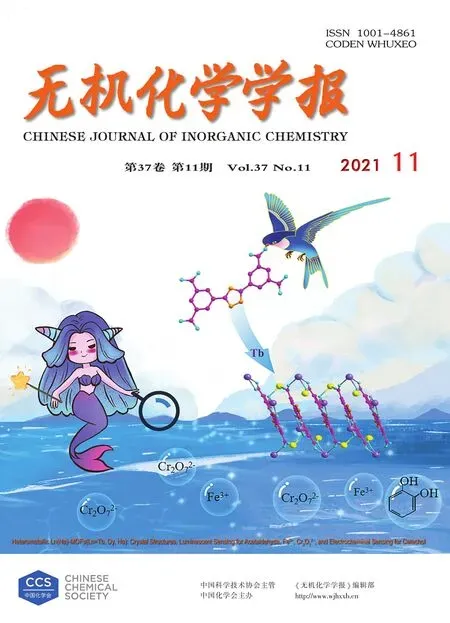Preparation of Dehydrated Ni-Fe Hydrotalcite-like Compounds as an Eco-Friendly Catalyst for Highly Selective Acetalization of Biomass-Derived Furfural
CHENG Shu?YanKOU Jia?WeiCHENG Fang?Qin
(1State Key Laboratory of Clean and Efficient Coal Utilization,Taiyuan University of Technology,Taiyuan 030024,China)
(2College of Environmental&Resource Science,Shanxi University,Taiyuan 030013,China)
(3Shanxi Laboratory for Yellow River,Shanxi University,Taiyuan 030013,China)
Abstract:The dehydrated Ni?Fe hydrotalcite?like compounds(Ni?Fe HTLCs)containing nitrate anions were synthe?sized and applied in furfural acetalization at room temperature.The dehydrated Ni?Fe HTLCs showed good selectivi?ty for furfural acetalization and achieved almost complete conversion of furfural.The dehydrated Ni?Fe HTLCs as water?tolerant Lewis acids and water scavengers was proved to be an efficient bifunctional catalyst for furfural ace?talization.The removal of interlayer water leads to shrinkage of Ni?Fe HTLCs particles and increase in electronic repulsion among NO3-ions in the interlayer.The weak acid sites in Ni?Fe HTLCs play an important role in furfural acetalization.The dehydration changes structure of the acid sites and thus improves activity of the weak acid sites.The dehydrated Ni?Fe HTLCs can absorb the most of the resulting water during furfural acetalization,but the struc?ture of Ni?Fe HTLCs cannot completely recover after rehydration possibly due to hindering effect of organic mole?cules diffusing into interlayer space.
Keywords:hydrotalcite?like compound;furfural;acetal;bifunctional catalyst;bio?oil
0 Introduction
The conversion of biomass,such as agricultural and forest residues,into biofuel and value?added chem?icals is one of the most sustainable routes to decrease the dependency on fossil fuels and thus to control CO2emissions[1].The bio?oil contains more than 400 organ?ics compounds such as guaiacols,phenols,furfural and their derivatives[2].The furfural(about 4%)in lignocel?lulosic bio?oil can undergo polymerization at high con?centrations,and the furfural can polymerize with phe?nols to form phenol?furfural resin at high tempera?tures[3].Therefore,it is necessary to convert furfural into stable substances under mild conditions for stabili?zation and industrial application of bio?oil.
Acetalization reactions are viable routes to protect formyl groups in furfural.The furfural acetals(e.g.,fur?fural propyleneglycol acetal and furfural glycol acetal)can be extracted from bio?oil as flavouring food addi?tives,plant growth regulator,and high?performance fuel additives[4].Conventionally,formation of furfural acetal involves straight forward reaction of furfural with 1,2?or 1,3?diol catalyzed by Br?nsted or Lewis acids under reflux conditions.However,it is inevitable that the unwanted homopolymerization and copolymeriza?tion reactions of furfural in bio?oil are accelerated at elevated temperatures.Moreover,α,β?unsaturated aldehydes such as furfural are labile at elevated tem?peratures,and thus the furfural acetalization with 1,2?diol under reflux conditions will lead to a mixture of by?products and poor yield of the desired acetal[5].In recent years,it is reported that the direct acetalization of aldehyde with diol can undergo over solid acid cata?lysts at ambient temperature,and trichloroacetonitrile served as a water scavenger under mild acidic condi?tions[6],but the highly toxic trichloroacetonitrile is pos?sible to result in environmental pollution.An eco?friendly method should be developed for furfural acetal?ization under mild conditions.
In general,furfural acetalization is catalyzed by protonic acids(i.e.,HCl or H2SO4)[7],which result in a series of problems such as large generation of effluents,complex purification of products,difficult neutraliza?tion of residues and serious corrosion of equipments[8].The use of the Br?nsted acid catalysts raises serious environmental matters.Therefore,to deal with these en?vironmental problems resulted from the homogeneous Br?nsted acid catalysts,a lot of attention has been recentlyattractedtothedevelopmentofenvironmentally?friendly heterogeneous catalysts.Several solid acids(e.g.,cerium chloride[9],cerium phosphate[10]and propyl phosphonic anhydride[11])have been used as catalysts in the furfural acetalization.Although benign to the environment,these catalysts sometimes suffer leaching problems or deactivation[7].Accordingly,these solid acids catalysts are not easy to be reused.The use of transition?metal Lewis acids containing Pd[12]or Rh[13]obtain good results for the acetalization reactions,but the noble metal catalysts are very expensive and usual?ly unstable[14].Thus,the Lewis acid catalysts with noble metals are difficult to be applied in an industrial scale.In brief,the development of an eco?friendly catalyst that is easily separable,reusable,and stable has been long?expected for the acetalization reactions.
Hydrotalcite?like compounds(HTLCs),a kind of layered double hydroxides(LDHs),have a network of double?layer structure with mesopores and/or micro?pores,and anions between the layers and cations in their layers are exchangeable.Generally,their composi?tion is represented by the following formula[15]:[M1-x2+Mx3+(OH)2]x+[Ax/nn-]·mH2O,where divalent cation(M2+)may be Mn2+,Cu2+or Zn2+,etc.;trivalent cation(M3+)may be Al3+,Ga3+or Cr3+,etc.;anion(An-)may be CO32-,NO3-,OH-,etc.;x(0.2≤x≤0.33)is the trivalent cation substitution degree in the hydroxy layer[16].Besides anions intercalating between the brucite?type layers,crystallization water molecules(mH2O)into interlayers connect the hydroxyl groups of the brucite?type layers through hydrogen bonds[17].HTLCs are widely used as photoelectric material,catalysts,and precursor of composite materials[18].An unusual feature of HTLCs is the memory effect.The water molecules in interlayer of HTLCs can be removed by heating,and the dehydrated HTLCs can recover the original hydro?talcite structure by absorbing water[19].Accordingly,we anticipated that the dehydrated HTLCs can play a dual role as a Lewis acid catalyst and a water scavenger dur?ing furfural acetalization.
In our present work,Ni?Fe HTLCs were prepared by a co?precipitation method.Subsequently,the dehy?drated Ni?Fe HTLCs were systematically character?ized,and their catalytic performance for furfural acetal?ization was evaluated.The objective of this work was to investigate the effects of structure and properties on catalytic performance of the dehydrated Ni?Fe HTLCs for the furfural acetalization.
1 Experimental
1.1 Preparation
According to Ni/Fe molar ratios of 2.0,60 mL of Ni(NO3)2and 30 mL of Fe(NO3)3aqueous solutions(1.0 mol·L-1)were mixed in a beaker.Subsequently,NaOH(1.0 mol·L-1)and Na2CO3(0.5 mol·L-1)aqueous solu?tions with appropriate volume were simultaneously and dropwise added into the mixture containing Ni(NO3)2and Fe(NO3)3under continuously stirring.The precipi?tation reaction was carried out at a constant pH value(pH=5.4±0.3).The obtained slurry was aged at 110 ℃for 4 h in a hydrothermal autoclave,and then the pre?cipitate was separated by filtration and rinsing with deionized water.Afterwards,the leached powder was dried at 80℃ for 2 h under vacuum to obtain the as?synthesized Ni?Fe HTLCs(HT?as)without physically adsorbed water.HT?as was dried at 150℃ for 2 h under vacuum to remove interlayer water and thus to obtain the dehydrated Ni?Fe HTLCs(HT?dh).
1.2 Characterization
Powder X?ray diffraction(XRD)patterns of the samples were recorded in the 2θrange of 5°?80°at a speed of 8(°)·min-1on a D/max?2500 X?ray diffractom?eter(Rigaku Co.,Ltd.,Japan)with CuKαradiation(λ=0.154 nm).The operating voltage and current were 30 kV and 100 mA,respectively.
The diffuse reflectance infrared Fourier transfor?mation(DRIFT)spectra were recorded on a Vertex?70 infrared spectrometer(Bruker Co.,Ltd.,Germany)over a co?addition of 200 scans at 4 cm-1resolution,and the sample was placed in a 0030?102 diffuse reflectance cell(Pike Co.,Ltd.,USA)equipped with ZnSe win?dows.Before the infrared measurement was performed,the diffuse reflectance cell was vacuumized to elimi?nate the moisture in the atmosphere and water adsorbed on the surface of the samples,and then high purity argon(99.999%)was introduced as protection gas.
Ammoniatemperatureprogrammed desorption(NH3?TPD)was measured on a ChemBET?3000 absorp?tion apparatus(Quantachrome Co.,Ltd.,USA).The samples(0.05 g)were loaded in a quartz vessel and then thermostated at 100℃for 0.5 h.The vessel was cooled down to 50℃.After the surface of the sample was completely adsorbed and saturated in ammonia at 50℃,the temperature of the sample was increased from 50 to 500℃ at a rate of 10℃·min-1by a temperature?programmed controller.The tail gas was analyzed by a thermal conductivity detector(TCD).To eliminate the disturbance of produced H2O and NOxduring decomposition of Ni?Fe HTLCs,TCD signals of the same samples(0.05 g)without ammonia were recorded under the same testing condition prior to NH3?TPD measurement,and the signals of the blank test as background signals were subtracted from original NH3?TPD profiles.
The specific surface area(SBET),pore volume(VBJH)and average pore diameter(Dave)were measured by stat?ic nitrogen adsorption?desorption on a QDS?30 physi?sorption instrument(Quantachrome Co.,Ltd.,USA)at-196℃.Prior to test,the samples were degassed at 200℃for 4 h.
The thermogravimetric(TG)and the differential thermogravimetric(DTG)curves were measured in argon gas on a Setsys Evolution thermogravimetry(Setaram Co.,Ltd.,French)at a heating rate of 10℃·min-1from room temperature to 1 000℃.
Scanning electron microscopy(SEM)characteriza?tion was performed at 20 kV on a JSM?6010plus/LV scanning electron microscope(Japan Electron Optics Laboratory Co.,Ltd.,Japan)to observe the morphology and microstructure of the samples pretreated by sput?tered Au.
1.3 Evaluation
Furfural reacted with ethylene glycol to form furfu?ral glycol acetal(FGA)under mild reaction conditions.In this work,the solvents and reactants were analytical grade(mass ratio ofca.99%).Furfural and ethylene glycol were purchased from Sigma?Aldrich.Prior to being used,furfural was freshly distilled with collec?tion of the middle fraction under reduced pressure and then stored under a nitrogen atmosphere.To prevent hydrolysis of the formed acetal,the syntheses were per?formed in an excess of ethylene glycol aiming to shift the equilibrium toward the desired acetal.In addition,the excessive ethylene glycol can combine with water by hydrogen bonding and thus prevented hydrolysis of the acetal.The excessive ethylene glycol severed as solvent and dehydrant.Despite the large excess,the ethylene glycol can be recovered by vacuum distilla?tion and reused in another reaction.In a general proce?dure,a mixture of furfural(9.61 g),ethylene glycol(62.1 g)and HT?dh(36.0 g)was added in a three?neck flask equipped with a thermostat and a magnetic stir?rer,and then the mixture was vigorously stirred for 7 h at 25 ℃.HT?dh served as a catalyst and a water scav?enger during furfural acetalization.Highly pure nitro?gen gas(99.999%)was used as protection gas.As a contrast,the mixture containing 5 mL of cyclohexane as an entrainer was refluxed at 100℃for 7 h,and the resulting water was separated by a Dean?Stark trap.The sampling was conducted at intervals of 1 h.Ni?Fe HTLCs were recycled from the reaction mixture by filtration and by washing with dichloromethane,and then the samples were dried at 80℃under vacuum to obtain the rehydrated Ni?Fe HTLCs(HT?rh)during the furfural acetalization reaction.The residual organic mixture was dried with anhydrous magnesium sulfate,filtered and concentrated under reduced pressure.The components of the mixture were analyzed on an Agilent 7890B gas chromatograph(Agilent Technologies Co.Ltd.,USA)equipped with a flame ionization detector(FID)and an OV?101 capillary column(0.2 mm×50 m).The column was heated from 50 to 160℃at a rate of 5 ℃ ·min-1.The temperatures of injector and FID were 200 and 230℃,respectively.The sampling vol?ume was 0.2 μL.The furfural conversion(X)and FGA selectivity(S)were calculated according to the follow?ing equations:


wherenf(mol)andnp(mol)are the amounts of furfural in reactants and products,respectively;nb(mol)is amount of FGA in products;ntis total amounts of vari?ous organic products.
The water content of the freshly prepared mixture was measured on a Tracera GC?2010 Plus(Shimadzu Scientific Instruments,Japan)equipped with a Water?col 1910 capillary column(0.32 mm×30 m)and a ther?mal conductivity detector(TCD).The samples and TCD were heated up to 150 and 250℃,respectively,and the carrier gas was helium at 1.5 mL·min-1with a split ratio of 100∶1.
2 Results and discussion
2.1 Structural and morphological analyses of Ni-Fe HTLCs catalysts
As shown in Fig.1,HT?as(Fig.1a)exhibits diffrac?tion peaks at approximately 2θ=9.9°,20.2°,34.5°,and 61.4°,which can be assigned(003),(006),(009)and(110)reflections of HTLCs,respectively[20].No other diffraction peak was detected in the XRD patterns,indicating high purity of the crystalline phases.Remov?al of interlayer water in HT?dh was evidenced by the shift of(003)diffraction peak from 2θ=9.9°to 2θ=11.9°(Fig.1b).In addition,the(003)diffraction peak of HT?dh broadened in comparison with HT?as,suggest?ing long?range ordering in Ni?Fe HTLCs is decreased after dehydration.The intensity of the characteristic(006),(009),and(113)reflections of HT?dh at 2θ=21.7°,35.8°,and 62.6°,respectively,decreased remarkably in comparison with HT?as,which implies an important disorder in the stacking of the layers in the dehydrated sample.The(003)diffraction peak began to sharpen again after rehydration(Fig.1c),which reveals that rehydration involves not only the physical diffusion of water molecules into the interlayer space of Ni?Fe HTLCs,but also a phase transition from the disordered dehydrated phase back to the original ordered hydrotalcite.The XRD patterns of HT?as(Fig.1a)and HT?rh(Fig.1c)were very similar except that the intensity of the diffraction peaks for HT?rh was slightly lower than the intensity for HT?as,indicating incomplete recovery of hydrotalcite structure after rehy?dration during the furfural acetalization reaction.
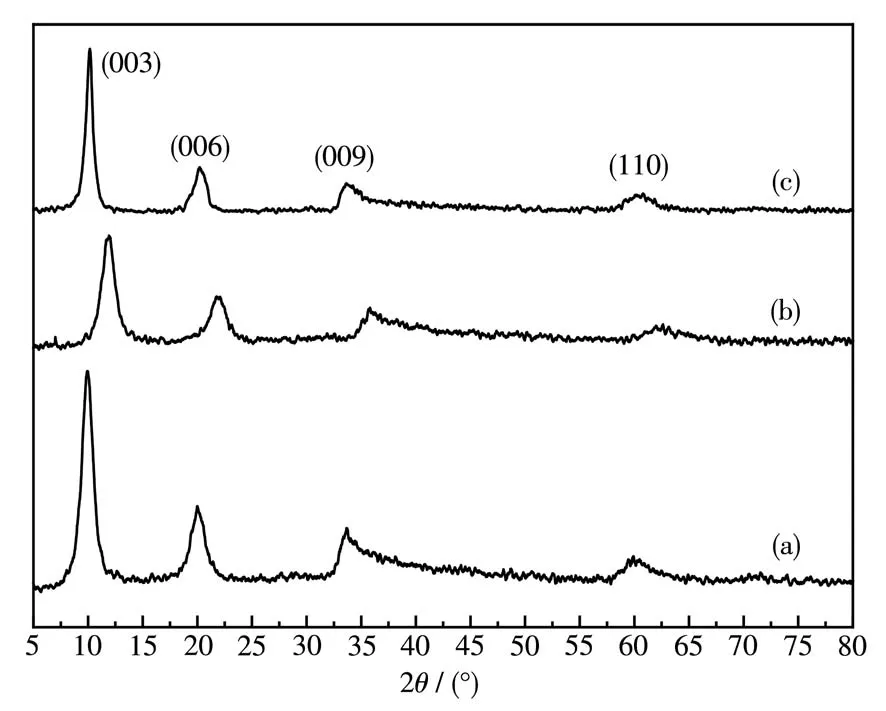
Fig.1 XRD patterns of HT?as(a),HT?dh(b),and HT?rh(c)
The XRD patterns showed that Ni?Fe HTLCs have a typical layered structure with 3R symmetry of HTLCs,which agrees well with the results reported in previous literature[21].Assuming a hexagonal 3R stack?ing sequence of adjacent brucite?type layers,the parametersaandccan be obtained from basal spacing of crystal planes(110)(d(110))and(003)(d(003)),respec?tively(c=3d(003);a=2d(110)).The parameterais used as a quantitative measure of the intermetallic average dis?tance[16].The parametercrelates to the distance between a brucite?type layer and an interlayer,which depends on the size of interlayer anions and/or electro?static forces between cations in the layers and interlay?er anions[22].As shown in Table 1,the parameterawas not altered significantly upon dehydration,the changes in the parametercwere observed in the following order:HT?dh Table 1 Crystallographic data calculated by XRD results The DRIFT measurements were taken to under?stand the structure of Ni?Fe HTLCs,and the infrared spectra were shown in Fig.2.For HT?as and HT?rh sam?ples(Fig.2a and 2c),the broad band was observed at 3 454 cm-1,which is attributed to the stretching of hydrogen?bonded hydroxyl groups in the interlamellar water molecules and the brucite?type layers[23].The bands at 1 047 and 825 cm-1are assigned to the defor?mation mode of Ni—OH and Al—OH[24].The bands centered at 1 386 cm-1correspond to the stretching of NO3-ions[25].For HT?dh(Fig.2b),the maximum of the broad band shifted from 3 454 to 3 620 cm-1,indicating the presence of isolated hydroxyl groupsin the layer of the dehydrated Ni?Fe HTLCs.In addition,the band centered at 1 386 cm-1was split into two bands cen?tered at 1 382 and 1 324 cm-1,indicating that the decrease in the interlayer space of Ni?Fe HTLCs leads to the reorganization of the NO3-anions in the interlay?er.The band at 1 324 cm-1is due to the conversion of symmetry fromD3hin HT?as toCs,C3v,orC2vsymmetry in HT?dh[26].The lower symmetry degree of NO3-ions in HT?dh may result from the restricted freedom degree of the NO3-ions in the confined interlayer space and the increase in electronic repulsion among NO3-ions in the absence of water.No band of organic molecules was detected in the infrared spectra,indicating that the adsorbed organic compounds were removed completely. Fig.2 DRIFT spectra of HT?as(a),HT?dh(b),and HT?rh(c) The textural properties of samples are summa?rized in Table 2.The pore sizes of all the samples were in a range of 2?50 nm,and thus Ni?Fe HTLCs were regarded as mesoporous materials.HT?dh presented an obvious decrease inSBET,VBJHandDavecompared to HT?as due to the particle shrinkage after dehydration.For HT?rh,a slight decrease in theSBET,VBJHandDavewas detected in comparison with HT?as,indicating that the physical structure of Ni?Fe HTLCs cannot be com?pletely recovered after rehydration during furfural ace?talization reaction. Table 2 Textural properties of the catalysts As shown in the TG?DTG curves of HT?as(Fig.3),there were three regions where the loss of weight occured:(1)5%of weight loss between 40 and 87℃due to the removal of physisorbed water;(2)13%in the range of 87?257 ℃ due to the removal of interlayer water;(3)43%for the temperature interval of 257?556℃due to thermal decomposition of NO3-ions and dehydroxylation.The first and second weight?loss steps are not separated clearly by a well?defined plateau.The removal rate of interlayer water reached to a maxi?mum at 140 ℃,and 13%mass of Ni?Fe HTLCs was lost after dehydration. Fig.3 TG?DTG curves of HT?as Generally,the acetalization reaction was cata?lyzed by Br?nsted acids or Lewis acids.Based on experimental results and literature[7],a plausible mech?anistic proposal involving the metal cations in a layer of Ni?Fe HTLCs is depicted in Scheme 1.Therefore,the cations as Lewis acids on the surface of Ni?Fe HTLCs should be the catalytic active sites,and the sur?face acidity of Ni?Fe HTLCs catalysts was analyzed.As shown in Fig.4,the NH3?TPD profiles suggest a signifi?cant concentration of acidic sites on the surface of all the samples.The desorption peaks in the range of 50?250 ℃ were attributed to weak acidic sites of Ni?Fe HTLCs catalysts,and the peaks in the range of 250?380℃were ascribed to strong acidic sites.The relative areas of the desorption peaks of HT ?dh were signifi?cantly higher than those of HT?rh and HT?as,but the specific surface area of HT?dh was smaller than HT?rh and HT?as,indicating higher acidity of Lewis acidic sites in absence of interlayer water.In comparison with HT?rh and HT?as,the peak shape of weak acidic sites for HT?dh began to sharpen,and the peak maximum of the weak acidic sites shifted from 124 to 155℃after dehydration,suggesting that dehydration leads to the change in structure of weak acidic sites in layers of Ni?Fe HTLCs.H2O and NO3-anions in the interlayer of Ni?Fe HTLCs are directly coordinated to the matrix Ni2+cations in layers of Ni?Fe HTLCs through oxygen atoms.The removal of interlayer water may lead to a structural rearrangement of the metal complex.Accord?ingly,the interlayer water molecules increase electron?ic cloud density of the metal cations(i.e.,decrease in the acidity of Lewis acidic sites)by coordinating with metal cations,and thus their electronic cloud density decrease after dehydration,namely the increase in com?bining capacity with electron donors. Scheme 1 Proposed reaction mechanism of furfural acetalization catalyzed by Ni?Fe HTLCs(Mn+represents metal cations in layers of Ni?Fe HTLCs) Fig.4 Plots of NH3?TPD signal against temperature for HT?as(a),HT?dh(b),and HT?rh(c) The dehydration and rehydration hardly lead to a significant change in the morphology of Ni?Fe HTLCs,and thus HT?as was used as typical sample to analyze the morphological characteristics of the catalysts.As shown in Fig.5,the angular sheets of Ni?Fe HTLCs were clearly observed.The lamellar morphology of irreg?ularly shaped particles was formed by the stacked thin flakes,indicating that successful preparation of Ni?Fe HTLCs with structural characteristics of hydrotalcites. Fig.5 SEM image of HT?as As shown in Fig.6,the FGA conversion increased significantly with the increasing reaction time and then reached to a maximum after about 5 h.The maximum conversions were observed in the following order:HT?dh(95.1%)>HT?as(81.4%)>HT?rh(77.8%),indicating high activity of HT?dh for furfural acetaliza?tion.The result is consistent with the change in the amount of acid sites in the three samples.The acidity of weak acid sites in HT?dh was much higher compared with HT?as and HT?rh,and moreover the structure of weak acid sites in HT?dh was changed by dehydration.Therefore,weak acid sites of the dehydrated Ni?Fe HTLCs play a major role in furfural acetalization.The selectivity of HT?dh,HT?as,or HT?rh to FGA was always higher than 97%,indicating that the side?reactions of furfural is difficult to undergo during ace?talization reaction at room temperature.In comparison with HT?as,the lower activity of HT?rh results from its smaller specific surface area that is caused by incom?plete recovery of hydrotalcite structure.NO3-ions inter?calating between the layers of Ni?Fe HTLCs can restrain the diffusion of organic molecules into interlay?er space by steric hindrance but promote water occupy?ing the remaining space of the interlayer by hydration.However,it is inevitable that a small quantity of organ?ic molecules diffuses into the interlayer space during furfural acetalization,which may hinder the structural recovery of Ni?Fe HTLCs during rehydration.Analyses of water content in the products showed that 91.2%of the resulting water was absorbed by HT?dh,and the residual water may be captured by excessive ethylene glycol through hydrogen bonding.The amount of water absorbed by HT?as or HT?rh was negligible.Hence,the resulting water was mainly absorbed by interlayer of HT?rh,and HT?rh showed strong selective absorp?tion of H2O during furfural acetalization.In summary,the high activity of HT?dh for furfural acetalization results from high acidity of weak acid sites and strong dewaterability. Fig.6 Conversion of FGA for all samples Under reflux conditions,the furfural acetalization over HT?dh was carried out as a contrast.As shown in Fig.6,the FGA conversion increased to a maximum after about 3 h,and the maximum conversion reached to 85.3%.However,the selectivity of HT?dh to FGA was merely 41.4%under reflux conditions,and the col?or of the mixture changed from transparent to isabel?line.The homopolymerization and oxidation of furfural at high temperatures may lead to the complex mixture of by?products.The abundant by?products hindered heat and mass transfer,and it is inevitable that the cat?alysts and reactants were encapsulated by the poly?mers.Accordingly,the resulting by?products under re?flux conditions have negative effects on conversion of furfural and selectivity of the catalyst. In summary,the dehydrated Ni?Fe HTLCs containing NO3-ions were synthesized by the co?precipitation method and investigated by XRD,FTIR,NH3?TPD,and nitrogen adsorption?desorption measure?ments.The dehydrated Ni?Fe HTLCs showed good cat?alytic activity and strong dewaterability for furfural ace?talization reaction.The weak acid sites play an impor?tant in the catalytic activity of Ni?Fe HTLCs.Dehydra?tion leads to an increase in acidity of the acid sites pos?sibly due to the decrease in electronic cloud density of the metal cations in layers of Ni?Fe HTLCs.The remov?al of interlayer water leads to the increase in electronic repulsion among NO3-ions,which alters the structure of metal complex in a layer of Ni?Fe HTLCs.The struc?ture of dehydrated Ni?Fe HTLCs cannot completely recover after rehydration during furfural acetalization,because the organic molecules diffusing into interlayer space of Ni?Fe HTLCs may hinder the structural recovery. Acknowledgements:This work is financially supported by National Natural Science Foundation of China (Grant No.22108161),Shanxi Province Science Foundation for Youths(Grant No.201901D211297)and Shanxi Dadi Environment Investment Holdings Co.Ltd.(Grant No.228023901039).
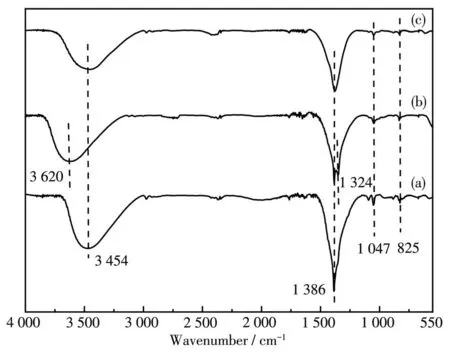

2.2 Thermal stability of Ni-Fe HTLCs
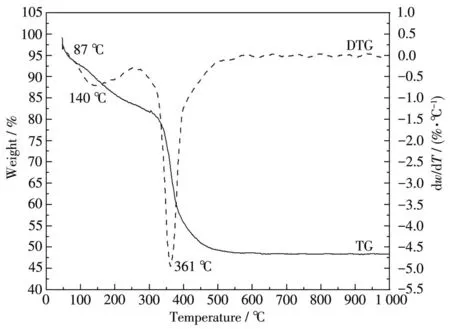
2.3 Surface acidity of Ni-Fe HTLCs

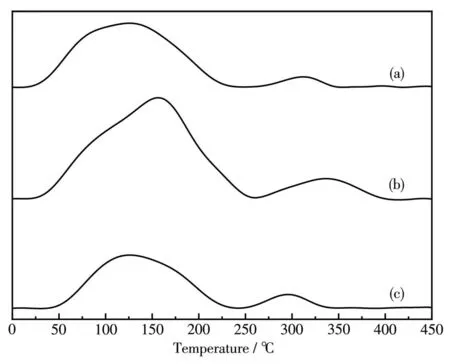
2.4 Morphological analyses of Ni-Fe HTLCs
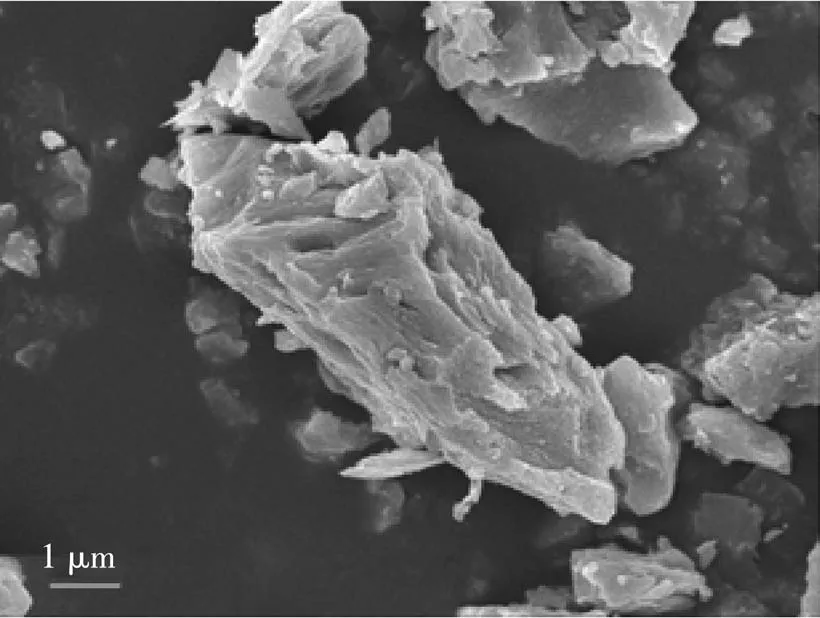
2.5 Catalytic performance
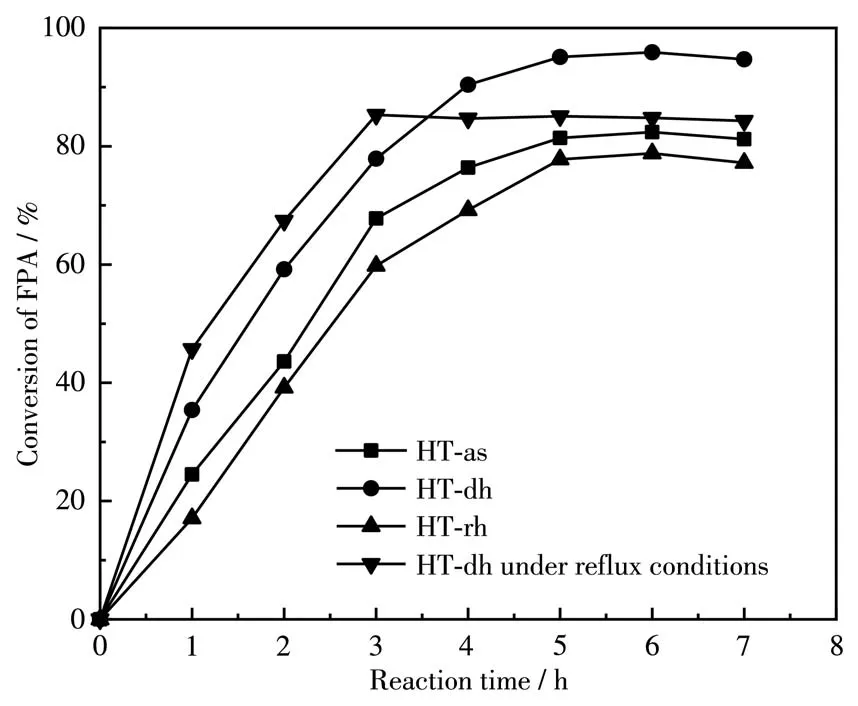
3 Conclusions
- 無機化學學報的其它文章
- Mn-Based Coordination Polymer:Facile Synthesis,Structure and Application in Glucose Electrochemical Sensing
- Synthesis,Structure Regulation and Characterization of Cadmium(Ⅱ)Complexes Based on Imidazole Carboxylic Acid Ligands
- Difunctional Effects of Organo-Modified T-Type Zeolite Membranes for Dewatering from Organic Solution
- Controlling Distribution of Gold Nanoparticles in Au@ZIF-8 Core-Shell Structures for Sensing Fluorescent Molecules with Photoluminescence
- Structures and Luminescence Property of Two Co(Ⅱ) and Cd(Ⅱ)Supramolecular Coordination Networks Created via Synergistic Effect of Coordination Bonds and Secondary Interactions
- Si摻雜調控15-冠-5配位Li+機理的理論研究

